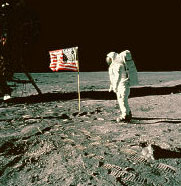|
|
The Eagle Has Landed
"On
July 16, 1969, three men and a support staff of thousands begin
the world’s greatest adventure: an attempt to successfully
land a man on the moon and return him safely again to earth. It
was the fulfillment of President John F. Kennedy's ambitious decade-long
goal for a nation struggling to keep ahead in the space race against
the Russians. The mission was Apollo 11. 
On
July 20, while Michael Collins lingered aboard the Columbia command
module in lunar orbit, Neil Armstrong and Buzz Aldrin headed for
the surface in the lunar lander, known as Eagle. With the fuel
supply dwindling, Eagle pilot Neil Armstrong realized that the
computerized trajectory was sending them toward a field of boulders.
He overrode the computer controls, setting the lander down on
the lunar shore with 15 seconds’ worth of fuel to spare.
The Eagle had landed.
What
began as a cold war race to control the skies had ended in an
unparalleled triumph for mankind. For the first time ever, a man
had walked upon the face of a world other than this earth!"
The
following were designated "Eagle Missions" because each
mission, except Apollo 13* successfully landed humans on the surface
of the moon.
|
| |
|
Apollo 11

|
(Columbia and Eagle)
July
16-24, 1969
Duration: 8 days, 3 hours, 18 minutes
Landing site: Sea of Tranquility
Milestones: First manned lunar landing mission
and lunar surface EVA Flag and instruments deployed; Unveiled plaque
on the LM descent stage with inscription: "Here Men From Planet
Earth First Set Foot Upon the Moon. July 1969 A.D. We Came In Peace
For All Mankind."
|
Apollo 12

|
(Yankee Clipper and Intrepid)
November
14-24, 1969
Duration: 10 days, 4 hours, 36 minutes
Landing site: Ocean of Storms
Milestones: Retrieved parts of the unmanned
Surveyor 3, which had landed on the Moon in April 1967. Apollo Lunar
Surface Experiments Package (ALSEP) deployed. LM descent stage impacted
on Moon.
|
Apollo 13*

|
(Odyssey and Aquarius)
April
11-17, 1970
Duration: 5 days, 22.9 hours
Milestones: Third lunar landing attempt.
Mission aborted after rupture of service module oxygen tank. *Classed
as "successful failure" because of experience in rescuing
crew. Spent upper stage successfully impacted on the Moon.
|
Apollo 14

|
(Kitty Hawk and Antares)
January
31 - Febraury 9, 1971
Duration: 9 days
Landing site: Fra Mauro
Milestones: ALSEP and other instruments
deployed. Lunar surface stay-time, 33.5 hours; 67 hours in lunar
orbit, with 34 orbits. 2 S (Extra-Vehicular Activities) of 9 hours,
25 minutes. Third stage impacted on Moon. Gathered 94 pounds. (42
kilograms) of lunar material using hand cart for first time to transport
rocks.
|
Apollo 15

|
(Endeavor and Falcon)
July
26-August 7, 1971
Duration: 12 days, 17 hours, 12 minutes
Landing site: Hadley-Apennine region (Near Apennine Mountains)
Milestones: First to carry orbital sensors
in service module of CSM. ALSEP deployed. Scientific payload landed
on Moon doubled. Improved spacesuits gave increased mobility and
stay-time. Lunar Roving Vehicle (LRV), electric-powered, 4-wheel
drive car, traversed total 17 miles. Small sub-satellite left in
lunar orbit for first time.
|
Apollo 16

|
(Casper and Orion)
April
16-27, 1972
Duration: 11 days, 1 hour, 51 minutes
Landing site: Descartes Highlands
Milestones: First study of highlands area.
Selected surface experiments deployed, ultraviolet camera/spectrograph
used for first time on Moon, and LRV used for second time.
|
Apollo 17

|
(America and Challenger)
December
7-19, 1972
Duration: 12 days, 13 hours, 52 minutes
Landing site: Taurus-Littrow (Highlands and valley area)
Milestones: Three EVAs totaled 22 hours,
4 minutes. Evans performed trans-Earth EVA lasting 1 hour 6 minutes.
Last lunar landing mission. First scientist-astronaut to land on
Moon - Schmitt. Sixth automated research station set up. LRV traverse
total 18.9 miles (30.5 km).
|
|